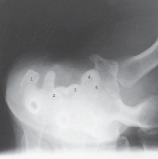A) 5° proximally (toward the wrist)
B) 10° distally (away from the wrist)
C) 15° proximally (toward the wrist)
D) 20° distally (away from the wrist)
F) A) and D)
Correct Answer

verified
Correct Answer
verified
Multiple Choice
Which carpal bone is 5?

A) Trapezium
B) Trapezoid
C) Hamate
D) Scaphoid
F) C) and D)
Correct Answer

verified
Correct Answer
verified
Multiple Choice
MATCHING Select the correct manual exposure adjustment for each disease or condition. -Advanced rheumatoid arthritis
A) Increase (+)
B) Decrease (-)
C) No change (0)
E) A) and C)
Correct Answer

verified
Correct Answer
verified
Multiple Choice
A patient with a history of carpal tunnel syndrome comes to radiology.The physician wants to rule out abnormal calcifications in the carpal sulcus.Which of the following projections would best demonstrate this region?
A) Coyle method
B) Jones method
C) Carpal bridge
D) Gaynor-Hart method
F) A) and B)
Correct Answer

verified
Correct Answer
verified
True/False
Carpal tunnel syndrome is more common in middle-aged women than in middle-aged men.
B) False
Correct Answer

verified
Correct Answer
verified
Multiple Choice
MATCHING Select the correct manual exposure adjustment for each disease or condition. -Advanced Paget's disease
A) Increase (+)
B) Decrease (-)
C) No change (0)
E) A) and B)
Correct Answer

verified
Correct Answer
verified
Multiple Choice
How many carpal bones are found in the wrist?
A) 14
B) 8
C) 5
D) 7
F) None of the above
Correct Answer

verified
Correct Answer
verified
Multiple Choice
A lateral elbow radiograph demonstrates about half of the radial head superimposed by the coronoid process of the ulna.Which of the following occurred?
A) The hand was pronated rather than in a true lateral position.
B) The hand and wrist were rotated laterally and not in a true lateral position.
C) The shoulder was not dropped sufficiently to the tabletop level.
D) No positioning errors occurred.
F) A) and B)
Correct Answer

verified
Correct Answer
verified
Multiple Choice
An ellipsoidal joint allows movement in ____ directions.
A) two
B) all
C) four
D) six
F) All of the above
Correct Answer

verified
Correct Answer
verified
Multiple Choice
Grids are generally not required unless the anatomy measures greater than _____ cm in thickness.
A) 8
B) 10
C) 14
D) 5
F) C) and D)
Correct Answer

verified
Correct Answer
verified
Multiple Choice
Which of the following actions will lead to the proximal radius crossing over the ulna?
A) Supination of the hand
B) Placing epicondyles parallel to image receptor
C) Pronation of the hand
D) External rotation of elbow
F) A) and C)
Correct Answer

verified
Correct Answer
verified
Multiple Choice
MATCHING Select the correct manual exposure adjustment for each disease or condition. -Osteomyelitis
A) Increase (+)
B) Decrease (-)
C) No change (0)
E) A) and C)
Correct Answer

verified
Correct Answer
verified
Multiple Choice
Which of the following best demonstrates the radial head using the trauma lateral Coyle method routine?
A) Elbow flexed 80°, CR angled 45° away from shoulder
B) Elbow flexed 90°, CR angled 30° toward shoulder
C) Elbow flexed 90°, CR angled 45° toward shoulder
D) Elbow flexed 90°, CR perpendicular to image receptor
F) All of the above
Correct Answer

verified
Correct Answer
verified
Multiple Choice
Which two structures form the distal radioulnar joint?
A) Radial notch and radial head
B) Ulnar notch and head of ulna
C) Radial tuberosity and ulnar notch
D) Coronoid tubercle and radial notch
F) B) and D)
Correct Answer

verified
Correct Answer
verified
Multiple Choice
Why is it recommended that the medial oblique projection be performed rather than the lateral oblique for the second digit of the hand?
A) To minimize optimal immunomodulating dose (OID)
B) To be more comfortable for the patient
C) To open up joints better
D) To improve radiographic contrast
F) A) and C)
Correct Answer

verified
Correct Answer
verified
Multiple Choice
Match each fracture description with the corresponding term.(Use each choice only once.) -Fracture of base of first metacarpal
A) Smith fracture
B) Barton fracture
C) Colles' fracture
D) Bennett's fracture
E) Boxer's fracture
G) A) and C)
Correct Answer

verified
Correct Answer
verified
Multiple Choice
Local or generalized infection of bone or bone marrow caused by bacteria introduced by trauma or surgery is a condition termed:
A) osteomyelitis.
B) Paget's disease.
C) osteoarthritis.
D) cellulitis.
F) B) and D)
Correct Answer

verified
Correct Answer
verified
Multiple Choice
How much rotation of the hands is required for the AP oblique bilateral (Norgaard method) hand projection?
A) 45°
B) 30° to 35°
C) 5° to 10°
D) 20°
F) B) and D)
Correct Answer

verified
Correct Answer
verified
Multiple Choice
Which one of the following structures is NOT part of the ulna?
A) Styloid process
B) Radial notch
C) Ulnar notch
D) Coronoid tubercle
F) None of the above
Correct Answer

verified
Correct Answer
verified
Multiple Choice
From a pronated position,which of the following is required for a PA oblique projection of the fourth digit of the hand?
A) 45° medial rotation
B) 30° to 35° lateral rotation
C) 30° to 35° medial rotation
D) 45° lateral rotation
F) A) and D)
Correct Answer

verified
Correct Answer
verified
Showing 81 - 100 of 107
Related Exams